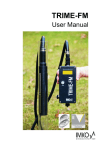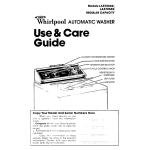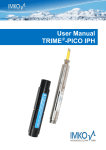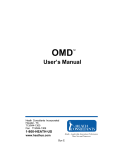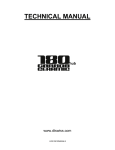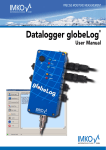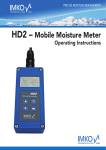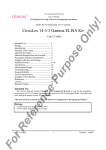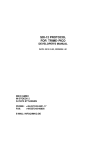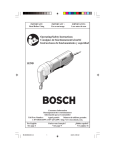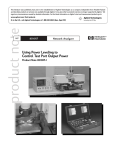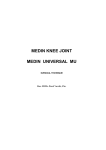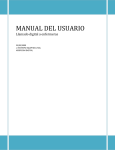Download TRIME®-IPH
Transcript
TRIME -IPH ® User manual Thank you for buying IMKO. Should you have any queries please don’t hesitate to contact your local distributor or address directly to IMKO: IMKO Micromodultechnik GmbH Im Stoeck 2 D-76275 Ettlingen Germany Phone: Fax: e-mail: internet: 2 +49-7243-5921-0 +49-7243-90856 [email protected] http://www.imko.de I:\PUBLIK\TECH_MAN\TRIME-IPH\ENGLISH\TRIME-IPH manual_e.doc Table of contents (as of January 1st, 2005) 1 Functional Description .................................................................................................................................. 4 1.1 TRIME-HD and TRIME Data Pilot operation ............................................................................................ 4 1.2 Data Logger Operation............................................................................................................................. 4 1.2.1 IMP232 Micronet output for use with the TRIME-Logger or ENVISLog (operation mode A) ........... 4 1.2.2 Analogue output for analogue data logger ....................................................................................... 4 1.2.3 PC-connection via RS232 ................................................................................................................ 5 1.3 External power supply .............................................................................................................................. 5 1.4 Error codes .............................................................................................................................................. 5 1.5 Technical Data ......................................................................................................................................... 5 1.5.1 The RS232-power supply cable ....................................................................................................... 5 1.5.2 Pin assignment................................................................................................................................. 6 1.5.3 Sensor data...................................................................................................................................... 6 2 The TRIME-T3 Tube Access Probe.............................................................................................................. 7 2.1 Introduction .............................................................................................................................................. 7 2.2 Measuring Field........................................................................................................................................ 7 2.3 Measuring experiences ............................................................................................................................ 8 2.4 Summary.................................................................................................................................................. 9 3 Access Tubes and Augers.......................................................................................................................... 10 4 Instructions for Access Tube Installation .................................................................................................... 11 4.1 Inserting and Fixing the Rubber Bung.................................................................................................... 11 4.2 Inserting T3 into the TECANAT Tube .................................................................................................... 13 5 Attention with the B3M/B3L Borehole Probe............................................................................................... 14 6 Distant Power Supply of TRIME Sensors ................................................................................................... 15 7 Basic Alignment with the Calibration Set .................................................................................................... 16 7.1 What is a basic alignment? .................................................................................................................... 16 7.2 What are the benefits of the calibration set for the user? ....................................................................... 16 7.3 How to make the basic alignment? ........................................................................................................ 16 7.3.1 Preparation of the glass beads....................................................................................................... 16 7.3.2 Basic alignment procedure............................................................................................................. 16 8 Material Specific Calibration ....................................................................................................................... 18 9 Connector’s Mounting................................................................................................................................. 18 10 Connector’s Assembly ................................................................................................................................ 19 11 EMV/EMI Precaution .................................................................................................................................. 20 12 Information on Lightning Protection of the ENVIS Environmental Measurement System (IMP232 Micronet Bus, Logger and integrated Sensors) ......................................................................................................... 20 12.1 Introduction ............................................................................................................................................ 20 12.2 Excess voltage protection on 110/220V mains supply ........................................................................... 20 12.3 Protection of modem and telephone lines .............................................................................................. 20 12.4 Excess voltage protection for network modules by "SM-Blitz"................................................................ 20 12.5 Lightning protection on meteorological towers ....................................................................................... 20 12.6 Installation instructions for SM BLITZ lightning protection modules ....................................................... 21 12.7 Conclusion ............................................................................................................................................. 21 I:\PUBLIK\TECH_MAN\TRIME-IPH\ENGLISH\TRIME-IPH manual_e.doc 3 1 Functional Description The intelligent and compact TRIME-IPH sensor is a measurement devices for continuous and nondestructive determination of volumetric soil moisture. It is designed for mobile field use and can be connected to TRIME T3/T3C or TRIME-B3M/B3L. TRIME-IPH has to be supplied with external power 9-24V/AC. They are designed for being connected to a TRIME-HD, a TRIME Data Pilot, a data logger (Trime-Logger or any analogue data logger) or a PC for monitoring and data logging purposes. 1.1 TRIME-HD and TRIME Data Pilot operation TRIME-IPH is simply screwed onto the sensor and is then connected to the 7-pin connector of the TRIME-Data Pilot. Please refer to the TRIME-HD or TRIME Data Pilot manual for operating instructions. 1.2 Data Logger Operation TRIME-IPH are supplied with an IMP232 Micronet interface or, on request, with both analogue output 0..1V, 0..20mA or 4..20mA and RS232 interface. Analogue datalogger must have differential inputs. 1.2.1 IMP232 Micronet output for use with the TRIME-Logger or ENVISLog (operation mode A) Intelligent TRIME sensors can be connected directly to the IMP232 Micronet. Networking several sensors requires distribution modules. IMKO supplies 3-port, 6-port and 12-port distribution modules. The number of simultaneously measuring sensors can be set. Please note that the IMP232 Micronet’s cable length and cable diameter have to be harmonized. Otherwise the energy consumption of the TRIME sensors (200mA during 10..15s) can cause a voltage drop. TRIME-IPH sensors are configured at works for use within the IMP232 Micronet (internal code = operation mode A). 1.2.2 Analogue output for analogue data logger TRIME-IPH sensors can easily be connected to conventional analogue data loggers with differential input. The maximum apparent ohmic resistance for the analogue output 0(4)..20mA is: Without error code = 80Ω (per m cable [∅ 0,34mm²] less 0,1118Ω) With error code = 28Ω (per m cable [∅ 0,34mm²] less 0,1118Ω) Depending on application and energy supply it can be chosen between two operation modes B and C: operation mode B: single measurement after power on. The measured value is available until power off. operation mode C: cyclic measurement with permanent power supply. The measurement rate is adjustable. The operation modes are set at works. Re-configuration by use of software TRIMESET possible. 1.2.2.1 Single measurement (operation mode B) Enables low power consumption in field installations. TRIME-IPH is started by the data logger relay. The measurement takes 10..15s and consumes 200mA. After the measurement the power supply switches off. The measurement value is available at the analogue output and is stored in the TRIMEsensor until the next measurement is started by the data logger relay. 4 I:\PUBLIK\TECH_MAN\TRIME-IPH\ENGLISH\TRIME-IPH manual_e.doc In case a voltage drop occurs when several TRIME sensors measure simultaneously the probe numbers (please note: probe number ≠ serial number) can be set in series and thus a serial, retarded measurement start can be forced. Then TRIME sensor number 1 measures immediately after power on, number 2 measures 20s retarded, number 3 measures 40s retarded, etc. The probe number can be configured using SMCAL or SMTOOLS. 1.2.2.2 Cyclic measurement (operation mode C) Operation mode C requires mains supply. TRIME-IPH enable automatic interval measurement in stand-by modus. Measurement rates between 10 and 3600s can be configured via PC/RS232/software TRIMESET. The measurement takes 10 .. 15s and consumes 200 mA. During stand-by 8 .. 10 mA are consumed. The measurement value is available and stored in the TRIMEsensor until the next measurement starts. 1.2.3 PC-connection via RS232 The TRIME-IPH can be connected to a PC via the RS232 connector and the appropriate cable, in order to carry out datalogging, changing the operating mode, or calibration. 1.3 External power supply Within the IMP232 Micronet the energy supply of sensors can be ensured by battery, solar cells or mains supply. For serial connection of a great number of sensors or long IMP232-bus cables a power amplifier module (SM-23LV) or decentralised power supply is advisable 1.4 Error codes Only valid with the IMP232 Micronet: In case of failure an “Error No.” and an “Error Address” is given out. Error No. Error Text Possible Cause of Error No text internal error 30 TDR may be defective TDR electronic or probe cable defective 31 TDR level not found TDR level searching lasted too long, may occur with bad signal quality due to conductive soil or material 33 Salinity too high Electrical conductivity of soil/material too high 34 Invalid probe data Data in probe connector not plausible or probe connector defective 1-29 1.5 Technical Data In the following technical data is given on cable, connectors and the IPH sensor. 1.5.1 The RS232-power supply cable 7pin male cable connector / RS232 3 4 2 1 5 7 front view 6 +U RxD 0V TxD NC NC NC 1 2 3 4 5 6 7 Power Supply red connector black connector 1 2 3 4 5 6 7 8 9 DB9-Connector for RS232/V24 I:\PUBLIK\TECH_MAN\TRIME-IPH\ENGLISH\TRIME-IPH manual_e.doc 5 1.5.2 Pin assignment Connector TRIME-IPH Connector: - power supply - RS232/V24 - analogue output Version IMP-Bus 2 Pin 1: Pin 2: Pin 3: Pin 4: 3 1 4 +U power supply R/T IMP232 network 0V power supply COM IMP232 network colours: green red pink/brown blue front view Version analogue output and RS232/V24 interface 4 3 5 2 7 6 1 front view Pin Pin Pin Pin Pin Pin Pin 1: 2: 3: 4: 5: 6: 7: +U RxD 0V TxD 0..1V or 0..20mA AGND n.c. colours: green yellow pink brown white grey -- Via the serial interface re-calibration and adjustment of parameters is done. 1.5.3 Sensor data Power supply: 7..24V-DC Supply current: 8mA standby 250mA while 10..15sec. measuring time Measuring range: 0..60% volumetric water content Accuracy: dependent on soil or material calibration. re-calibration is possible per free software TRIME WinCAL. (download under www.imko.de) Range 0...40%: ±2% Range 40..70%: ±3% Repeated accuracy: ±0,5% Bulk electrical conductivity : 0..2dS/m (T3), 0..5dS/m (T3C) Temperature range: -10°C...50°C, other temperature ranges on request Temperature drift: max. ±1,8% Interface: RS232/V24 Analogue output: 0..1V, 0..20mA or 4..20mA Calibration: free configurable, universal calibration for mineral soil as standard, material specific calibration required for clay and organic soil 6 Cable length: standard 3,5m; special length on request Case: waterproof sealed PVC (IP68) I:\PUBLIK\TECH_MAN\TRIME-IPH\ENGLISH\TRIME-IPH manual_e.doc 2 The TRIME-T3 Tube Access Probe 2.1 Introduction The measuring of soil water content with Time Domain Reflectometry is now a well established method. However water content profiling is not possible with conventional TDR rod probes. The TRIME tube probe was developed for this reason. Since 1994 the TRIME-T3 has found numerous applications in earth and environmental sciences, fulfilling even the most exacting requirements. 2.2 Measuring Field The effective penetration depth of the probe is about 15 cm with the highest sensitivity in the immediate vicinity of the access tube and decreases exponentially with distance. Figure 3 shows the electric field distribution of the probe and the approximate measuring volume. effective measurement volume equipotential lines aluminum plates Figure 1: Electric field distribution of the TRIME probe and approximate measuring volume. The elliptical measuring volume enables a higher representation to be achieved by several measurements rotating the probe after each measurement and calculating the mean value. The following experiment illustrates the high penetration depth of the measuring field: In a bucket of 50 cm diameter filled with water saturated glass beads a moisture of 44 vol.-% is measured. Measuring in a smaller bucket (see Fig. 3) would result in essentially lower measuring values due to an amount of air within the measured volume. Figure 2: Influence of a too small measuring volume on water content determination. I:\PUBLIK\TECH_MAN\TRIME-IPH\ENGLISH\TRIME-IPH manual_e.doc 7 Note that the necessity of a close contact between access tube and material is vital for reliable measurements and that the tubes should be installed by our recommended method. • For example at an assumed water content of 15 vol. % an air gap of 1 mm around the whole length of the tube would result in an underestimation of 1 - 2 vol. %. • At a water content of 25 vol. % the error would be 5 vol.-%. • At very high water contents (50 vol. %) errors may reach 10 vol. %. • In the case of a water filled gap under conditions of saturation the gap error would be much smaller. − Problems may arise, however, in very inhomogeneous soils and when drilling under very dry conditions. For these soils other drilling methods are recommended (e. g. pre-boring with an Edelman auger, washing mud into the cavity around the tube). Losses in accuracy must then be accepted, and measurements immediately after installation are not recommended. − Problems can also arise in swelling and shrinking soils, since cracks develop especially along the access tubes. 2.3 Measuring experiences The new TRIME technique was thoroughly tested in the field and compared both to neutron probe measurements and thermo gravimetrically determined values. Figure 3: Comparison of TRIME measurements and gravimetric water content determination for a clayey soil. Figures 5 and 6 show a comparison of water content determinations for a loess and for a heavy clay, made with a neutron probe (Wallingford), the TRIME-T3 probe, and the gravimetric method. In contrast to the neutron probe, which is not suitable for measurements near the surface due to radiation losses to the atmosphere, TRIME has no problem at all to measure directly at the soil surface. 8 I:\PUBLIK\TECH_MAN\TRIME-IPH\ENGLISH\TRIME-IPH manual_e.doc Figure 4: Figure 5 : Comparison of neutron probe, TRIME-T3 and gravimetric method for water content determinations in a loess soil. Comparison of neutron probe and TRIME-T3 for water content determinations an illitic clay. Some materials, especially very clayey soils and soils with high organic contents, can afford material specific calibrations due to their different dielectric behaviour. A limiting factor in TDR measuring is the bulk soil electrical conductivity. For the TRIME-T3 tube probe, bulk soil electrical conductivity should not exceed 1 dS/m. Note that bulk soil electrical conductivity is a combination of the pore water electrical conductivity and the surface conductivity of the soil matrix. Due to the tortuous nature of the conductivity path in the soil (soil type dependent), the bulk soil conductivity is much lower than the electrical conductivity of the pore water and it is dependent on water content. 2.4 Summary The TRIME tube probe is a promising new tool for determining water content profiles with the TDR method. Fast, routine and non destructive measurements of water content without the use of hazardous radioactive materials are possible. A measuring accuracy of ± 2 vol.-% is possible, provided that soil and access tube are in close contact and bulk soil electrical conductivity doesn’t exceed 1 dS/m. I:\PUBLIK\TECH_MAN\TRIME-IPH\ENGLISH\TRIME-IPH manual_e.doc 9 3 Access Tubes and Augers The penetration depth of the measurement field of the 44mm TRIME tube-access-probe is up to 150mm into the soil. The measurement sensitivity is the highest near the access tube and decreases exponentially into the medium. Therefore the insertion method of the access tube is very important. Ramming head with clamp device Auger equipment for the direct setting of the access tubes into homogeneous soils. Screw auger with handle Small version without soil anchors for access tubes with 1m length Pre-boring with an Edelmanauger Fixing of the rubber bung TECANAT access tube Support pillar with clamp device Soil anchor Internal steel guide and protection tube Clamp device for rubber bung Steel cutting shoe of access tube Pre-boring of bore holes with standard augers destroy the soil texture, because it is difficult to come to a good and close contact of the access tube inside the soil. With the described auger equipment it is possible to set the access tubes directly into homogenous soils without pre-boring. In very stony soils it is not possible to use this method. Therefore it could be possible to use an Edelman-Auger for preboring and closing the air gaps with mud. Changes in soil structure, and a delay time (up to 4 weeks) before it is possible to come to precise measurement values must then be accepted. The IMKO auger equipment consists of: access tube support pillar with three soil anchors, ramming head with clamp device, screw auger with handle, clamp device for the rubber bung, and an internal steel guide/protection tube. Deliverable is a small version without soil anchors for setting of glass fibre tubes with 1m length. A steel cutting shoe is glued into the access tube. The screw auger, that moves easily within the guide tube is used to drill out soil to about 0,1m below the cutting shoe. Depending on soil homogeneity, the tube can be hammered 5..10cm into the soil. This cycle is repeated until the tube is fully installed. The internal protection tube is then removed and the access tube can be sealed by a rubber bung. 10 I:\PUBLIK\TECH_MAN\TRIME-IPH\ENGLISH\TRIME-IPH manual_e.doc 4 Instructions for Access Tube Installation The following instructions should be taken account of: FixationScrew The ramming head, the TECANAT access tube and the internal steel guide and protection tube are one unit. Ramming Head The internal protection tube has to lie on with Clamp Device the cutting shoe of the access tube, before it can be fixed with a screw to the ramming head. This fixation is necessary to secure the shoe against being squeezed out by the returning force of the hammer-blow. The access tube, however, is fixed to Pull for best the ramming head by the clamp device. position Both fixation screw and clamp device should be controlled during the installation process and be re-adjusted with the adjustable levers if necessary. The screw auger, that moves easily within the guide tube is used to drill out soil to about 0,1m below the cutting shoe. Depending on soil homogeneity, the tube is then hammered 5-10 cm into the soil with a plastic hammer (with open support pillar clamps!). The guide tube is not used for making the hole in the first instance because this could result in soil compaction around the hole, which would lead to higher measurement values. The access tube support pillar with three ground anchors avoids vibrations that would cause air gaps. Then the clamp of the support pillar must be closed and the soil can be removed with the screw auger. When the tube reach the support pillar, it must be removed and the access tube can be inserted to the final depth without the support pillar. A plastic collar should be mounted around the tube to prevent water from running down the tube wall and a plastic cap to protect the tube against rain. 4.1 Inserting and Fixing the Rubber Bung 1. Orient the rubber bung with the black rubber washer downwards. 2. Insert the rubber bung into the TECANAT tube. 3. Let it glide down or push to the bottom of the tube. I:\PUBLIK\TECH_MAN\TRIME-IPH\ENGLISH\TRIME-IPH manual_e.doc 11 Black washer downwards! → 4. Fix the rubber bung with the screwing adaptor. The rubber bung can be pushed into the access tube with the screw- adapter and the handle (the screw-adapter can be replaced instead of the screw auger) and can be fixed at the bottom of the access tube with two turns of the handle. If pushing down the rubber bung turns out to be difficult, just apply some talcum powder on the rubber bung sides and into the access tube. 12 I:\PUBLIK\TECH_MAN\TRIME-IPH\ENGLISH\TRIME-IPH manual_e.doc 4.2 Inserting T3 into the TECANAT Tube When you are going to work with your TRIME-T3 tube access probe: Press the spring mounted wave-guides to the probe body when you insert the T3 probe into the tube. Thereby you avoid ripping off the spring mounted wave-guides. Depth markers (see picture right) are fixed along the cable in 1m steps from the measurement centre. The marker ears are positioned in direction of the oriented measurement field (see p.7) 1m from measurement center 2m from measurement center B lu e Co a x C a b le Sta rt Press TR IM E- H D Vo l% 2 Measurement 1 2 center 1 Press TRIME-IPH TRIME-HD or TRIME Data Pilot TECANAT plastic tube Please note Should you use new T3 probes (eight wave-guiding plates instead of two) in old GFK tubes, we advice to carefully chamfer the inner top side of the GFK tube. Thereby you avoid ripping off the spring mounted wave-guides. I:\PUBLIK\TECH_MAN\TRIME-IPH\ENGLISH\TRIME-IPH manual_e.doc 13 5 air pipe Attention with the B3M/B3L Borehole Probe cable A B3M/B3L probe is only suitable for limited bore hole diameter: maximum Ø105mm for the B3L probe maximum Ø52mm for the B3M probe. Do not inflate air into the bore hole probe when the probe is outside the bore hole. The packer rubber might be destroyed. 14 For pulling out the probe prepare it with a steel rope on the two hooks before letting down the drill well. Attention: the air needs time for deflating through the air pipe. The longer the air pipe the longer the deflation time. Control the deflating air flow at the valve and only pull out the probe from the bore hole after complete deflation of the probe. I:\PUBLIK\TECH_MAN\TRIME-IPH\ENGLISH\TRIME-IPH manual_e.doc 6 Distant Power Supply of TRIME Sensors The operation of TRIME sensors may cause problems when power has to be supplied via long cable lengths. There are limitations regarding the maximum cable length depending on the cable diameter. When power is supplied distantly the maximum cable length depends on the cable cross section A, the distribution voltage Vs and the number n of the sensors measuring simultaneously. Furthermore, device-specific data also enter the formula: Power consumption during measurements: Minimum sensor voltage at circuit end: Is= 200 mA Vmin = 7 V The maximum possible circuit length Imax can then be calculated in the following manner: I max = A ⋅ (Vs − Vmin ) 0.038Ω mm2 ⋅n ⋅ Is m This is explained in the following example: In the IMP232 environmental measurement system a bus cable with a wire cross section of A = 0.34 mm2 is normally used. We further assume that the power supply voltage is Vs =12 V and only one sensor is designated to measure. Thus n = 1. I max = 0.34mm 2 ⋅ (12V − 7V ) = 160m mm 2 ⋅1 ⋅ 0.20 A 0.038Ω m In the above calculation, no tolerance is included; for security reasons the calculated cable length should be reduced by 10% to obtain a realistic value. In order to increase the maximum possible cable length several solutions are feasible. 1. Using cables with larger conductor diameters by using 6-core conductor cables instead of 4-core, the cable length can be doubled as two extra cores can be used for power supply. cables with conductors having larger diameters will increase even further the maximum possible cable length. 2. Increasing the power supply voltage power supply voltage can be increased up to 17V. Thus the maximum length will increase from 160 m to 320 m in the example calculation above. 3. Installation of buffer batteries in the distributor additional storage batteries close to the TRIME sensors, e.g. in the distributor, allow cable lengths up to 1km and enable simultaneous measurement of several sensors. However, this method requires an additional charging circuit for the buffer storage battery. 4. Installation of a voltage regulator at the distributor voltage loss in the cable can be reduced with a 30V power supply and an installation of a voltage regulator directly in front of the TRIME sensor, thus allowing circuit lengths of up to 1km. Which solution is suiting best mainly depends on the nature of power supply of the measurement system: battery supply: solution 1 and possibly solution 3 should be considered, the latter being relatively expensive. mains supply: solutions 1 and 2 could be combined, or, more expensive, solutions 2 or 4 could be chosen. 7 Basic Alignment with the Calibration Set 7.1 What is a basic alignment? The basic alignment serves to compensate the cable length and tolerances of the probe mechanics (thickness of the rod coating, rod length, etc.). After two measurements, one in dry and one in water saturated glass beads, the calibration data is calculated and stored in the TRIME sensor. Every TRIME-IPH sensor must be calibrated before it can supply proper measurement results. The basic alignment is carried out by IMKO at works before shipment. 7.2 What are the benefits of the calibration set for the user? With the calibration set you can easily carry out the basic alignment with your TRIME sensor yourself. If defective probe rods must be changed you are able to make the required basic alignment by yourself. The calibration set can not be used for establishing a material (soil) specific calibration. For this purpose a measurement data set must be created on the specific material. In order to calculate the calibration data for this data set and to download it to the TRIME-probe the calibration program TRIME-WinCal is required. 7.3 How to make the basic alignment? 7.3.1 Preparation of the glass beads The glass beads, which are supplied with the calibration set, have to be prepared first: Fill up one bucket until the rods of the probe can be inserted completely. To achieve a constant density knock the bucket several times against the ground. * The density of the glass beads increases with frequent insertion of probes. Therefore the glass beads should be poured out into another bucket and poured back to achieve the original density. Now the second bucket has to be filled with water in order to be able to fill in the glass beads without air-bubbles remaining. An additional precaution to remove air-bubbles is to stir slightly while filling in the glass beads. The container must now be knocked against the ground several times to achieve a constant density. The surplus water must be poured out until the thickness of the water film above the glass beads is below 2mm. The water saturated glass beads should be in a temperature range between 20°C and 25°. * Attention: Water dissolves Na2O and K2O from glass which causes a rising pH-value and an increased electrical conductivity. New glass beads have to be washed intensively with tap water!!! 1. Fill a bucket with water 2. stir the beads under water 3. pour out the water. This procedure should be done with new glass beads at least five times, each time with fresh water. If the glass beads have been in use for a longer time, three times is sufficient. Please note that the electrical conductivity of the water saturated glass beads medium increases already after a few days storage. Therefore the glass beads must be washed again before the next calibration. 7.3.2 Basic alignment procedure The basic alignment has to be carried out using the calibration program TRIME WinCAl. Please read the information available in the help function about the basic alignment. 16 I:\PUBLIK\TECH_MAN\TRIME-IPH\ENGLISH\TRIME-IPH manual_e.doc Fig.: TRIME-IPH with T3 probe head inserted in a TECANAT calibration tube which again is installed in dry glass beads. Make sure that the tube probe’s wave guides are completely inserted into the glass beads when measuring. The basic alignment will fail if the wave guides are in part surrounded by air. I:\PUBLIK\TECH_MAN\TRIME-IPH\ENGLISH\TRIME-IPH manual_e.doc 17 8 Material Specific Calibration Your TRIME measuring system is working with a universal calibration for mineral soils as standard. Following parameters limit the application range of the universal calibration: Clay content: >50% Organic content: >10% Bulk density: <1,1kg/dm³ or >1,7kg/dm³ Exceeding the above limits may cause failures overstepping the tolerances given on page 5. Should your soil be among the above mentioned categories or if you want to go for the last digits in accuracy a material specific calibration is advised. For setting up a material specific calibration the software TRIME WinCal is used (download unter www.imko.de). For establishing a material specific calibration a test series with reference values is necessary (z.B. Oven drying at 105°C until constant weight). The test series –and consequently the calibration– should include minimum and maximum moisture values. TRIME readings and reference values are compared in a table. Then the calibration coefficients must be calculated and uploaded to the TRIME-device. 9 Connector’s Mounting The water tightness of connectors (IP67 = 30min / 1m water column) can only be guaranteed by observing the following: In case of carrying out the cabling of the distribution modules yourself, please make sure that the cable seals fit tightly. Only cables with a sheath diameter of 5 to 8mm shall be used. With smaller diameters water may enter the connector, the distribution box or the sensor. Altered measurements or destroyed electronics can be the consequence. IMKO supplies special seals. All unused connectors have to be protected by blind covers. IMKO supplies all equipment respectively all open connecting terminals protected by blind covers. Additional ones can be obtained at IMKO. When installing the connectors, special attention has to be paid to the connectors being threaded with care. The threads have to be aligned correctly to ensure efficient tightness. In addition, the connector should only be hand-screwed, i.e. without use of tools (e.g. pliers). 18 I:\PUBLIK\TECH_MAN\TRIME-IPH\ENGLISH\TRIME-IPH manual_e.doc 10 Connector’s Assembly In diesem Bereich einfetten ! Buchseneinsatz female insert Gewindering coupling ring In this area place a thin coat of grease ! Hülse mit Feder Shell with spring Dichtring gasket Druckring thrust coilar Druckring thrust coilar Druckschraube pressing screw Dichtring gasket Dichtring gasket Druckschraube pressing screw An den schwarz markierten Bereichen den Siliconkleber so dick auftragen, daß Dichtring und Kabel wasserdicht verklebt sind. Gewindering coupling ring I:\PUBLIK\TECH_MAN\TRIME-IPH\ENGLISH\TRIME-IPH manual_e.doc O-Ring At the black marked areas apply silicon glue so thick that the gasket and the cable are sticked together and are waterproofed. 19 11 EMV/EMI Precaution EMV/EMI precaution by means of ferrite filters ensures better disturbance suppression and therefore improves measurement accuracy. Ferrite filters are integrated in the TRIME sensor and at the connector side of the sensor cable. 12 Information on Lightning Protection of the ENVIS Environmental Measurement System (IMP232 Micronet Bus, Logger and integrated Sensors) 12.1 Introduction Lightning strokes can cause considerable and costly damages to unprotected electronics. The equipment is often totally destroyed. A good number of users are not or only partially insured. Customers who have a lightning protection insurance must comply with defined clauses regarding lightning and excess voltage. Insurances only cover the damage when the defined clauses have been complied demonstrably. IMKO strongly recommends adequate lightning / excess voltage protection equipment for ENVIS environmental measurement systems. 12.2 Excess voltage protection on 110/220V mains supply Lightning strokes in proximity to high-voltage transmission lines can cause excess voltage in the mains power supply which may result in damage of electronic components. Environmental measurement systems with 110/220V mains supply are endangered by this excess voltage. It may affect the whole system through the power supply unit and the central station (SM-MUX4 or SM-23U). Excess voltage can even enter the measuring system through the data acquisition computer’s mains power supply. An excess voltage protection is highly recommended for all 110/220V devices connected to the ENVIS system 12.3 Protection of modem and telephone lines Telephone lines are endangered by excess voltage. If a modem is connected to the measurement system the telephone line should also be protected by a lightning protection module. 12.4 Excess voltage protection for network modules by "SM-Blitz" Excess voltage caused by lightning strokes in close proximity to the environmental measurement test system may enter the IMP232 Micronet bus transmission lines. Longer lines increase the risk of lightning stroke. Theoretically maximum protection is achieved by installation of a lightning protection module (SM-Blitz) in front of each SM-Module. But actually reasonable compromises between costs and maximum protection level has to be found, i.e. interconnection of adjacent SM-Modules to lightning protected groups. 12.5 Lightning protection on meteorological towers SM-Modules installed on meteorological towers cannot be protected from a lightning strokes. The field strength resulting from the electromagnetic fields and the associated accumulated energy will cause damage to the electronics. Two solutions for the problem: Erect a higher lightning conductor close to the meteorological tower serving as a lightning collector. Install the measuring modules in a distance of some meters. Then all lines coming from the tower have to be protected by lightning protection modules. 20 I:\PUBLIK\TECH_MAN\TRIME-IPH\ENGLISH\TRIME-IPH manual_e.doc 12.6 Installation instructions for SM BLITZ lightning protection modules Basically, there are two potential risk sources in the field of environmental measurement technology: transmission lines and sensors or network devices. Lightning protection modules should always be installed at the beginning and at the end of a circuit in order to protect the electronics from excess voltage (Attention: SM-Blitz modules have a protected and an unprotected side). The SM-BLITZ lightning protection module has to be grounded using a ground conductor with a wire cross section of at least 6 mm2 screwed to the long side of the module. A grounding rod length 2 meter may serve as ground conductor. Grounding is optimal when the grounding rod is in direct contact with ground water. 12.7 Conclusion Only a limited protection against excess voltage is possible when it comes to natural phenomenon such as lightning stroke. Direct lightning strokes may cause damage nevertheless. If you have any questions regarding lightning protection do not hesitate to contact us. I:\PUBLIK\TECH_MAN\TRIME-IPH\ENGLISH\TRIME-IPH manual_e.doc 21





















